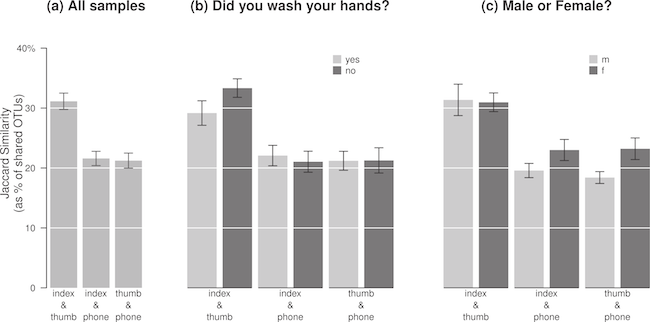Mobile phones are used for lifelogging by millions worldwide. But apparently all phones are used for logging our personal microbiome as researchers @ University of Oregon point out in this paper. Microbiome is our own and unique set of micro organisms that can identify us as an individual. And researchers have hypothesized that the set of bacteria we leave on our touch screens will reflect the bacteria found on our fingers.
The main findings are:
- 22% of the bacterial OTUs (operational taxonomic units) on the participants’ fingers were also on their phones. However, 82% of the the most common bacteria found in participants, those representing more than 0.1% of a single person’s dataset, were also found on their phones. Washing hands had no effect on the correlation between bacteria on the phone and that on subjects’ fingers.
- The researchers tested whether the bacteria a phone resembled the microbes from its owner more than those from other people. The answer was, not surprisingly, yes; each participant’s index finger shared, on average, 5% more bacteria with that person’s phone than with others’ phones.
- While all participants shared bacteria with their phones, there was a difference between the amount men shared and the amount women shared. Women seem to have more bacteria in common with their phones than men do.

Figure 2: The degree of overlap between bacterial pools differed by gender and by whether participants washed their hands. (A) Thumbs and index fingers on the same person shared, on average, 32% of their OTUs, while each digit shared about 22% with their own phone. The two fingers had significantly more in common than either did with phones (p < 0.001 for both fingers; from paired t-tests comparing the 1st bar in (A) to the 2nd and 3rd, respectively). (B) Hand-washing made a marginal but insignificant difference in the resemblance of the two fingers (p = 0.126; comparing the 1st and 2nd bars in (B)), and no difference at all in the finger/phone connection (p = 0.7; comparing the 3rd and 4th bars in (B)); (C) Women’s fingers appeared to share more OTUs with their phones than men, but the difference was not significant (p = 0.128; comparing the 3rd and 4th bars in (C)) since both shared more OTUs, on average, with their own phones than with anyone else’s (Table 1).
From IT World:
The authors argue that our smartphones "hold untapped potential as personal microbiome sensors". They suggest that swabbing our phones could enable larger scale microbial studies which more invasive sampling methods might restrict. Combined with cheaper DNA sequencing technology, smartphones could also be used for things like easily screening health care workers for pathogens and to generally help us to better understand what kind of microbes we’re exchanging with our environment on a daily basis.
On the other hand, the thought of somebody being able to learn a lot about us by swabbing our smartphone screen may give people worried about privacy.
